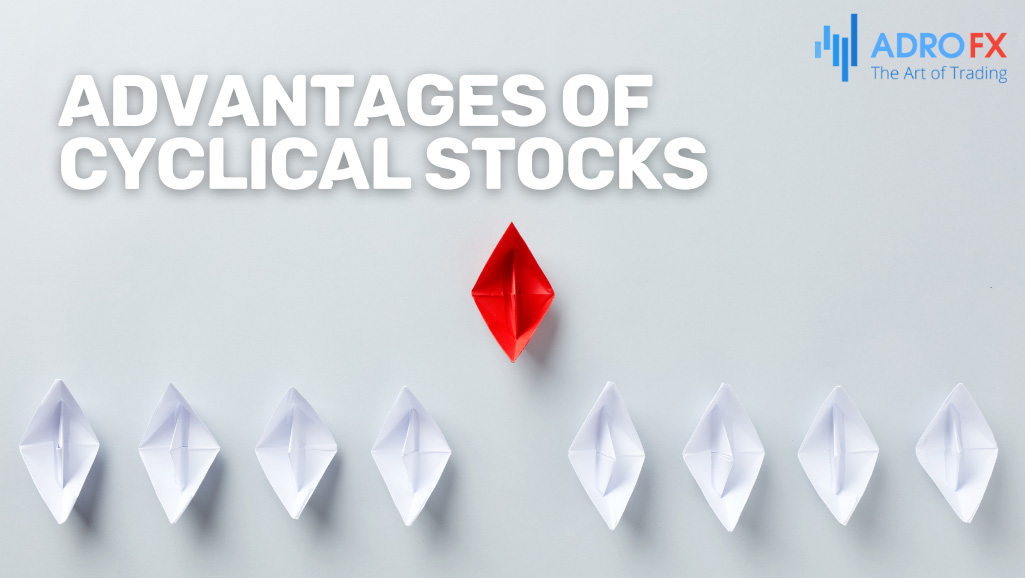Cyclical Stocks: Riding the Waves of Economic Expansion and Contraction

Cyclical and non-cyclical stocks represent varying degrees of correlation with the broader economy, influencing their price fluctuations. Cyclical stocks exhibit a direct relationship with economic conditions, while non-cyclical stocks tend to perform consistently regardless of economic growth rates.
Traders recognize that while economic cycles are beyond their control, adapting investment strategies to align with market fluctuations is essential. Understanding the dynamics between the stock market and the economy is crucial for navigating these transitions, distinguishing between companies affected by market trends and those resilient to economic shifts.
Cyclical Stocks
These stocks are intricately tied to economic trends, resulting in higher volatility in their stock prices. During periods of economic expansion, cyclical stock prices rise, and conversely, they decline during economic downturns. They mirror the phases of the economic cycle, including recovery, recession, peak, and expansion.
Cyclical stocks predominantly belong to industries that sell discretionary products and services, experiencing heightened demand during economic prosperity. Examples include automobile manufacturers, luxury retailers, furniture makers, airlines, hotel chains, and restaurants. Such stocks represent goods that consumers often cut back on during economic hardships.
When consumer spending on non-essential items decreases, the revenue of cyclical companies also declines, leading to a decrease in stock prices. In severe cases, some businesses may face bankruptcy during economic downturns. The strong correlation between cyclical stocks and the economy presents challenges in predicting stock prices, posing difficulties for traders considering investments in these stocks.
Non-Cyclical Stocks
Non-cyclical stocks consistently outperform the broader market even during periods of economic slowdown. These securities remain profitable irrespective of economic fluctuations as they produce and distribute goods and services with consistent demand. Examples include utilities, food, water, and power companies.
Non-cyclical companies offer defensive stocks, protecting traders from the impacts of economic downturns. They serve as stable investment options during periods of economic uncertainty. For instance, everyday household items like soap, shampoo, toothpaste, and dish detergent may seem trivial, but they are essential. Utility companies represent a prime example of non-cyclical stocks.
Daily necessities like heat and power ensure that utility companies maintain steady growth without the fluctuations seen in other sectors. While non-cyclical stocks offer stability and protection, they may not experience significant growth during periods of high economic expansion. Investing in these stocks can help mitigate losses during volatile market conditions.

Examples of Cyclical Stocks
Cyclical stocks encompass a wide range of industries that experience fluctuations in demand and profitability in tandem with changes in the business cycle. These stocks are often sensitive to economic conditions and tend to perform well during periods of economic expansion while facing challenges during downturns. Below are some examples of cyclical stocks across various sectors:
Automobile Manufacturers
Companies engaged in the production and sale of automobiles are considered cyclical stocks. During economic booms, consumers tend to have higher disposable income, leading to increased demand for vehicles. Conversely, during economic downturns, consumers may postpone purchasing new cars, resulting in reduced sales for automobile manufacturers. Examples include General Motors (GM), Ford Motor Company (F), and Toyota Motor Corporation (TM).
Airlines
Airlines operate in a cyclical industry characterized by fluctuations in demand driven by factors such as consumer spending, business travel, and fuel prices. During economic expansions, increased consumer confidence and corporate travel contribute to higher demand for air travel. Conversely, during economic downturns or periods of uncertainty, demand for air travel may decline. Examples include Delta Air Lines (DAL), American Airlines Group Inc. (AAL), and Southwest Airlines Co. (LUV).
Homebuilders
Companies involved in residential construction, such as homebuilders and building materials suppliers, are cyclical stocks. Demand for new homes is closely tied to economic conditions, interest rates, and consumer confidence. During periods of economic growth and low-interest rates, demand for housing tends to rise as individuals seek to purchase homes. Conversely, during economic downturns or rising interest rates, demand for new homes may decrease. Examples include D.R. Horton Inc. (DHI), Lennar Corporation (LEN), and PulteGroup Inc. (PHM).
Luxury Goods Retailers
Luxury goods retailers cater to affluent consumers and are often considered cyclical stocks. Consumer spending on luxury items such as high-end fashion, jewelry, and luxury vehicles tends to be discretionary and sensitive to changes in wealth and consumer sentiment. During economic expansions and periods of strong consumer confidence, demand for luxury goods may increase. However, during economic contractions or times of economic uncertainty, consumers may scale back on luxury purchases. Examples include LVMH Moët Hennessy Louis Vuitton SE (LVMH), Tiffany & Co. (TIF), and Burberry Group plc (BRBY).
Leisure and Entertainment
Companies operating in the leisure and entertainment sector, including hotels, casinos, theme parks, and cruise lines, are often classified as cyclical stocks. Demand for leisure and entertainment activities is influenced by consumer discretionary income, travel trends, and overall economic conditions. During economic expansions, consumers may increase spending on leisure activities and travel. Conversely, during economic downturns or periods of uncertainty, consumers may cut back on discretionary spending, impacting the performance of leisure and entertainment companies. Examples include Marriott International Inc. (MAR), Wynn Resorts Ltd. (WYNN), and Carnival Corporation & plc (CCL).
These examples highlight the diverse range of industries that fall under the category of cyclical stocks and illustrate how their performance is closely tied to fluctuations in the business cycle and broader economic conditions. Investors interested in cyclical stocks should conduct thorough research and consider the potential risks and opportunities associated with investing in these sectors.

Advantages of Cyclical Stocks
Understanding the dynamics of cyclical stocks can provide investors with valuable insights into navigating the complexities of the stock market. As an integral component of investment portfolios, cyclical stocks offer unique advantages that can contribute to portfolio growth and diversification. By delving into the benefits of cyclical stocks, investors can make informed decisions to optimize their investment strategies and capitalize on opportunities presented by economic cycles.
Potential for High Returns
Cyclical stocks often experience significant price swings during economic cycles. When the economy is in an expansion phase, these stocks tend to outperform, leading to potentially high returns for investors. This characteristic makes them attractive to traders seeking substantial gains during periods of economic growth.
Opportunities for Timely Investments
Due to their sensitivity to economic trends, cyclical stocks present opportunities for well-timed investments. Investors who can accurately anticipate shifts in the economic cycle can capitalize on the upturns and downturns in these stocks, maximizing their investment returns.
Diversification Benefits
Including cyclical stocks in a diversified investment portfolio can enhance overall portfolio performance. Since these stocks have a different risk-return profile compared to non-cyclical or defensive stocks, they can provide diversification benefits, reducing the overall risk exposure of the portfolio.
Alignment with Economic Growth
Cyclical stocks are closely tied to economic growth, making them aligned with the broader macroeconomic environment. As the economy expands, companies in cyclical industries experience increased demand for their products and services, driving revenue growth and potentially boosting stock prices.
Sector Rotation Opportunities
Cyclical sectors tend to outperform during specific phases of the economic cycle, leading to opportunities for sector rotation strategies. By strategically rotating investments into cyclical sectors during economic expansions and reallocating to defensive sectors during downturns, investors can potentially enhance portfolio returns.
Potential for Dividend Growth
Some cyclical companies may offer dividend growth potential during periods of economic prosperity. As these companies generate higher profits during economic expansions, they may increase dividend payouts to shareholders, providing income growth potential for investors.
Valuation Opportunities
Cyclical stocks may become undervalued during economic downturns, presenting buying opportunities for value-oriented investors. When market sentiment is pessimistic and cyclical stocks are trading at discounted valuations, investors with a long-term perspective can capitalize on the potential for future appreciation as economic conditions improve.
Investment in Growth Industries
Certain cyclical sectors, such as technology and consumer discretionary, represent growth industries with innovative products and services. Investing in cyclical stocks within these sectors can provide exposure to emerging trends and technological advancements, potentially leading to long-term capital appreciation.
Drawbacks of Cyclical Stocks
While cyclical stocks present enticing opportunities for investors, they also come with inherent drawbacks that warrant careful consideration. Understanding these potential pitfalls is essential for investors seeking to build resilient and balanced portfolios. By examining the drawbacks of cyclical stocks, investors can make informed decisions and mitigate risks effectively in their investment endeavors.
Market Sensitivity and Volatility
One of the primary drawbacks of cyclical stocks is their high sensitivity to macroeconomic factors and market conditions. Unlike non-cyclical stocks, which demonstrate resilience in various economic environments, cyclical stocks are heavily influenced by fluctuations in the business cycle. As a result, their prices can be highly volatile, subject to abrupt shifts in economic sentiment and broader market trends.
Economic Downturn Vulnerability
Cyclical stocks are particularly vulnerable during economic downturns or recessions. Since they operate in industries that rely on discretionary spending and consumer confidence, these stocks often experience significant declines in demand and profitability during periods of economic contraction. Consequently, investors holding cyclical stocks may face substantial losses as consumer sentiment weakens and businesses curtail spending.
Difficulty in Timing Market Cycles
Another challenge associated with investing in cyclical stocks is the difficulty in accurately timing market cycles. Successfully predicting economic downturns or recoveries is a daunting task, even for seasoned investors and financial analysts. As a result, investors may struggle to identify the optimal entry and exit points for their cyclical stock investments, leading to potential missed opportunities or losses.
Sector-Specific Risks
Cyclical stocks are also exposed to sector-specific risks that can impact their performance. Factors such as technological disruptions, regulatory changes, and competitive pressures can pose significant challenges for companies operating in cyclical industries. Additionally, certain sectors may be more susceptible to external shocks, such as changes in commodity prices or geopolitical events, further exacerbating volatility and uncertainty for cyclical stocks.
While cyclical stocks offer the potential for attractive returns, they also entail significant risks and challenges. Investors should carefully weigh the advantages and drawbacks of investing in cyclical stocks and consider their risk tolerance, investment objectives, and time horizon before allocating capital to these sectors. By adopting a prudent and diversified approach to investing, investors can navigate the complexities of cyclical markets and build robust portfolios capable of weathering economic fluctuations.

Selecting Cyclical Stocks
Investing in cyclical stocks requires careful consideration of various factors, including economic indicators, industry trends, and company-specific metrics. Here's a step-by-step guide to selecting cyclical stocks:
- Understand the Business Cycle
Cyclical stocks are closely tied to the business cycle, experiencing periods of growth and contraction in tandem with the broader economy. Begin by gaining a thorough understanding of the different phases of the business cycle, including expansion, peak, recession, and recovery. Identify where the economy currently stands in the cycle to determine which sectors and industries are likely to perform well.
- Analyze Economic Indicators
Monitor key economic indicators that provide insights into the health of the economy and specific industries. These indicators may include GDP growth, unemployment rates, consumer spending, industrial production, and housing starts. Positive trends in these indicators often signal economic expansion, favoring cyclical sectors such as consumer discretionary, industrials, and materials.
- Identify Cyclical Industries
Certain industries are more cyclical than others, experiencing significant fluctuations in demand and profitability throughout the business cycle. Examples of cyclical industries include automotive, housing, manufacturing, consumer discretionary, and travel and leisure. Focus your attention on sectors that are sensitive to changes in consumer spending, business investment, and overall economic activity.
- Conduct Sector Analysis
Once you've identified cyclical industries, delve deeper into sector analysis to evaluate specific companies within those sectors. Assess factors such as competitive dynamics, market share, pricing power, regulatory environment, and technological innovation. Look for companies with strong fundamentals, robust balance sheets, and competitive advantages that enable them to outperform their peers during economic upturns.
- Evaluate Company Performance
Analyze the financial performance and operational efficiency of individual companies within cyclical sectors. Review key metrics such as revenue growth, earnings per share (EPS), profit margins, return on equity (ROE), and debt levels. Pay attention to historical performance during different phases of the business cycle to gauge how effectively the company manages cyclical fluctuations.
- Assess Valuation
Determine whether cyclical stocks are trading at attractive valuation levels relative to their intrinsic value and growth prospects. Compare key valuation metrics such as price-to-earnings (P/E) ratio, price-to-sales (P/S) ratio, price-to-book (P/B) ratio, and dividend yield to industry peers and historical averages. Look for opportunities to invest in undervalued cyclical stocks with favorable long-term growth potential.
- Consider Risk Factors
Recognize the inherent risks associated with investing in cyclical stocks, including exposure to economic downturns, industry-specific challenges, and market volatility. Assess risk factors such as sensitivity to interest rates, commodity prices, geopolitical events, and regulatory changes. Diversify your portfolio across different sectors and asset classes to mitigate risk and enhance overall portfolio resilience.
- Monitor Market Trends
Stay informed about macroeconomic trends, geopolitical developments, and market sentiment that may impact cyclical stocks. Keep abreast of relevant news, economic data releases, and corporate earnings reports to identify emerging opportunities and potential risks. Maintain a disciplined approach to portfolio management and be prepared to adjust your investment strategy in response to changing market conditions.
By following these steps and conducting thorough research, investors can effectively select cyclical stocks that align with their investment objectives, risk tolerance, and time horizon. Remember to maintain a long-term perspective, diversify your portfolio, and stay disciplined in your investment approach to achieve sustainable returns over time.
Final Thoughts
In conclusion, understanding the dynamics of cyclical and non-cyclical stocks is crucial for investors looking to navigate the complexities of the stock market. While cyclical stocks offer the potential for high returns during economic expansions, they also come with inherent risks and challenges, including market sensitivity and volatility. On the other hand, non-cyclical stocks provide stability and protection during economic downturns but may lack significant growth potential during periods of high economic expansion.
By carefully weighing the advantages and drawbacks of each type of stock and conducting thorough research, investors can make informed decisions to optimize their investment strategies. Whether seeking opportunities for growth or prioritizing stability, a diversified portfolio that includes both cyclical and non-cyclical stocks can help investors achieve their long-term financial goals while mitigating risks associated with economic fluctuations. With a disciplined approach and a focus on fundamental analysis, investors can build resilient portfolios capable of weathering various market conditions and generating sustainable returns over time.
About AdroFx
Established in 2018, AdroFx is known for its high technology and its ability to deliver high-quality brokerage services in more than 200 countries around the world. AdroFx makes every effort to keep its customers satisfied and to meet all the trading needs of any trader. With the five types of trading accounts, we have all it takes to fit any traders` needs and styles. The company provides access to 115+ trading instruments, including currencies, metals, stocks, and cryptocurrencies, which make it possible to make the most out of trading on the financial markets. Considering all the above, AdroFx is the perfect variant for anyone who doesn't settle for less than the best.










